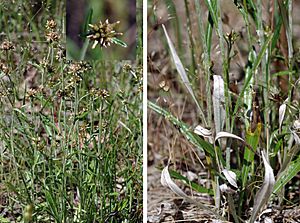Creeping cudweed facts for kids
Quick facts for kids Creeping cudweed |
|
|---|---|
 |
|
| Scientific classification | |
| Kingdom: | |
| (unranked): | |
| (unranked): | |
| (unranked): | |
| Order: | |
| Family: | |
| Genus: |
Euchiton
|
| Species: |
E. collinus
|
| Binomial name | |
| Euchiton collinus (Labill.) Cass.
|
|
| Synonyms | |
|
|
Euchiton collinus is a small plant often called creeping cudweed. It's a type of herb that grows close to the ground. You can find it naturally in Australia and New Zealand. It has also started growing in some parts of the United States, like California and Oregon.
About Creeping Cudweed
This plant is quite interesting because of how it grows and spreads. It can live for two years (biennial) or even longer (perennial). This means it doesn't just die after one season.
How Creeping Cudweed Grows
Creeping cudweed can grow up to about 40 centimeters (16 inches) tall. It spreads out using special stems called stolons and rhizomes. Stolons are like runners that grow along the ground. Rhizomes are underground stems. Both help the plant spread and create new plants.
The leaves of the plant grow in a circle at the bottom, forming a rosette. This rosette surrounds the main stem. Other leaves also grow individually higher up on the stem.
Its Flowers
This plant produces small groups of flowers called flower heads. These heads look like a single flower but are actually many tiny flowers grouped together. Each cluster is shaped like half a ball and is about 1 to 2 centimeters (0.4 to 0.8 inches) wide.
Each flower head has many tiny flowers inside. Around the edge, there are 40 to 60 "pistillate" flowers. These are female flowers. Closer to the center, there are 3 to 5 "bisexual" florets. These tiny flowers have both male and female parts.

